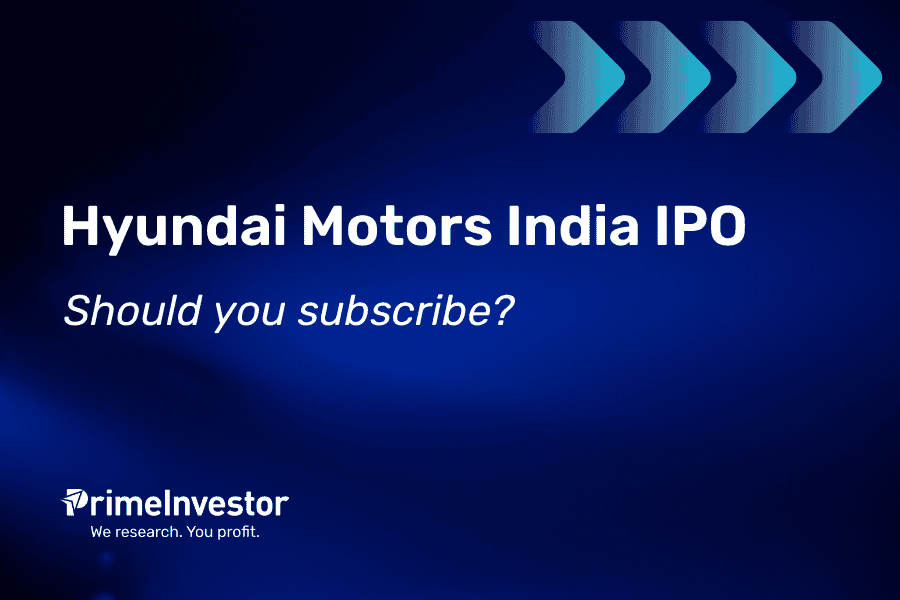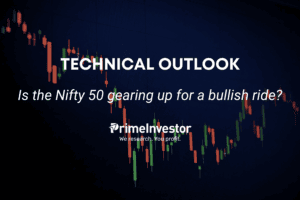There are few companies in India that can capture the attention of a common man who has never invested in stocks and inspire him to take a shot at it. Hyundai Motors India (HMI), the Indian arm of the South Korean automotive giant Hyundai Motor Company, fits the bill. It plans to launch its IPO after over two decades of successful operations in India. This will be India’s largest-ever IPO.

This is an offer for sale by the parent for 14.2 crore equity shares or 17% stake at a price band of Rs.1,865-1,960 per share at 27 times earnings.
At the upper end of the price band, it is looking to raise Rs.27,870 crore.
The IPO will be open for subscription from October 15 to 17 with listing on October 22.
Business
HMI is the second most successful MNC automobile maker in India after Maruti Suzuki with a track record of profitable operations. This is attributable to its understanding of market and ability to churn out models across small cars, sedans and SUVs. HMI has a journey mirroring Maruti’s, starting with its popular Santro small car but going on to cement its position in SUVs with Creta.
Products with a wide range of engines (Petrol, Diesel, CNG) and transmission options (Manual and Automatic) have made it a preferred brand in premium hatch backs and SUVs, something that even market leader Maruti hasn’t been able to achieve to perfection.
However, HMI’s market share has slipped in recent years on account of the structural change in the passenger car market. Domestic majors like Tata Motors and M&M have upped their ante in SUVs while customers have also made this shift, hurting players like Maruti and HMI who still market small cars and sedans. But HMI remains a strong player in its traditional strongholds.
Positives
#1. Higher revenue vs market share
HMI has just a 14.6% market share in passenger cars compared to Maruti’s 41% share. But it generates almost half of Maruti’s sales and profits with a third of its market share. This is clearly reflected in its revenue of Rs 70,000 crore Vs Maruti’s Rs 1,41,585 crore. This can be attributed to HMI’s more premium positioning, which allows it to enjoy higher realisations. It also has a higher share of SUVs in its portfolio mix at over 60% versus the market’s SUV share of 50%.
HMI has also been a major beneficiary of the ‘SUV-isation’ of the Indian car market, with SUVs increasing their share from 18% in FY14 to 50% in FY24. HMI scores in mid-size SUVs with its popular Creta with a 38% market share. It trails Maruti (27.5%) in the compact SUV segment with 17% market share. Creta has been a phenomenal success for HMI and the EV version of it is about to debut in Q4 of FY25.
Overall, HMI’s positioning is extremely strong in the large mid-market segment as it dominates premium hatchbacks, sedans and mid-sized SUVs. This focus is likely to continue as it has exited Santro. It is trying to straddle the upper end with its full-sized SUV Alcazar. This will help HMI to maintain its growth with high revenue share.
#2. Low-cost buyout to fuel capex
Automobiles is a tough business where a combination of product successes, cost controls and operating leverage determine profitability. HMI has two plants in Chennai that are operating at 103% and 92% capacity respectively, with Plant-1 producing 354,000 units and Plant 2 producing 4,16,000 units annually. HMI has plans to produce 1 million units annually.
To this end, it has acquired General Motors’ plant located in Maharashtra in December 2023. This capacity addition is happening at the right time, at a cost lower greenfield plant as it this sale marked GM’s exit from India. While the consideration for the plant has not been disclosed, HMI plans to invest Rs.6,000 crore over the next four years in phases, to produce 2,50,000 units.
Following this, the Chennai plant will be used for EV production and battery assembly, while the Maharashtra plant will take care of exports. Hyundai plans to reap economic benefits arising out of Tamil Nadu Govt’s incentives on EV production while using the proximity of Maharashtra plant to the ports to ship to Middle East and African markets.
#3. Strong financial performance and high-quality balance sheet
HMI has sustained profitable operations and built up a rock-solid balance sheet in the 25 years since its inception in India. Its equity capital has remained the same at Rs.812 crore since 1999 while it has accumulated reserves and surpluses many times this equity base. While it had accumulated reserves of close to Rs.19,242 crore in FY23, it has paid out a mammoth dividend to its parent in FY24, leaving behind reserves of Rs 9,853 crore in FY24. This payout while draining HMI of cash prior to the IPO has also propped up its Return on Equity and Return on Capital Employed to 56.8% and 62.9% in FY24.
HMI’s track record on product launches has been impressive with many blockbusters and relatively few failures. This is testimony to its ability to leverage its parent’s R&D and understanding of the Indian market. Automobile OEMs often struggle with high R&D costs and uncertainties of product success or failure.
This is also perhaps why HMI is demanding a steep valuation premium over its Korean parent, which is trading at a PE of about 5 times on the South Korean bourses. Such valuation differences exist in the case of Maruti and Suzuki as well.
Here is a quick glimpse into its financial performance:
At this point of time, HMI scores a bit over Maruti for its premiumisation focus, better return ratios and parent’s strong hold on EVs.
Here’s a quick comparison between HMI and Maruti
#4. Grounds-up approach to EV journey
A key disruptor for Indian automobile OEMs is the market gravitating towards electric vehicles with a strong policy nudge. HMI has been a somewhat late entrant to the EV race but is well-placed to crack this market, given its overseas success in EVs. HMI has launched EV-SUV KONA followed by IONIQ 5 in India, both fully imported models. But it couldn’t offer it at attractive price points due to the hefty import duty of 100% on imported cars. But there’s some progress on this front.
Learning from the success of Tata Motors in providing a compelling value proposition to consumers by building EVs on the same platform as ICE vehicles, HMI is gearing up to launch the Creta EV in Q4 FY25 leveraging on its ICE platform.
HMI has recently signed a Rs 20,000 crore MoU with the TN government over 10 years (2023 to 2032) to manufacture EVs, battery pack assembly and set up charging stations. HMI’s parent has signed an MoU with Exide Energy Solutions to localize EV battery production. This grounds-up approach with significant localisation initiatives gives confidence w.r.t HMI’s EV journey.
5. Exports, a key contributor to growth
HMI is the second-largest exporter of automobiles from India and derives a fourth of its revenue from exports to Latin America, Middle East, and South Africa. Exports earn slightly higher margins compared to domestic sales with government export incentives. Exports also act as a hedge during downturns in domestic markets and contribute to capacity utilisation. The upcoming Maharashtra plant can help HMI press the accelerator on exports, provided demand conditions stay supportive.
Concerns
#1. Top-of-cycle numbers
Like all IPOs, HMI’s offer is timed to take advantage of particularly stellar numbers on growth and profitability due to the massive rebound in the auto sector from the Covid slump. The issue price demands a stiff valuation on these peak earnings. HMI was a significant beneficiary of SUV -isation.
With the share of SUVs expected to plateau around 50-55% and the industry cycle likely to turn down, HMI’s growth and profitability look set to taper down in the next 3 years, compared to the last three. There’s limited room for further market share gains and even expansion plans don’t push the math beyond 10-15% volume growth.
Furthermore, global automakers are facing increasing competition from Chinese automakers on EVs. If Hyundai attempts to mitigate a domestic slowdown through exports, the China factor and geopolitics could put speed breakers in the way of export growth.
#2. KIA a threat to HMI
KIA, wholly owned subsidiary of Hyundai Motor Corp, is a direct competitor to HMI in the Indian market. KIA is a strong player in the mid-SUV segment with 16% market share, where HMI has 30% market share. While the parent follows this dual brand strategy globally with independent go-to-market strategies, KIA’s arrival has put a dent in the market share of HMI. Without KIA, Hyundai would have dominated the mid-SUV segment.
Hyundai Motor Corp says it plans to aggressively grow both brands in India with a combined target of 1.5 million units, with a third coming from KIA. But given past experience with MNCs, conflicts of interest on product launches, allocation of resources and technology support cannot be ruled out. Maruti is grappling with similar conflicts on its SUVs due to Suzuki’s association with Toyota.
#3. Spike in royalty payments
One of the key risks in MNC stocks is parent companies trying to extract their pound of flesh when good times sustain. HMI seems to be going down this road, by entering into a revised royalty arrangement with its parent effective 1st April 2024. The company has begun to pay a fixed royalty to its parent at 3.5% of sales against its earlier arrangement where royalties averaged 2.3% of sales (three-year average) and were calibrated to each vehicle model. This may result in royalty outflows taking additional 1-1.25% bite out of sales and reducing EBITDA by margins to an similar extent.
Valuation
HMI’s IPO is priced at 27 times FY24 earnings, just a whisker below market leader Maruti Suzuki at 28 times. SUV and Tractor major M&M trades at a slightly higher multiple.
So, it might seem that subscribing to HMI IPO is not very different from investing in Maruti or M&M at current valuations. However, we have doubts about the valuation taking into account the following factors:
- One, as with many IPOs, the past data looks the best coming as it does at the peak of a rebound and going forward an imminent slowdown. So the valuation you pay now has to justify future growth. However, the future growth is likely to be much flat (or even a decline in FY25) as the industry slows.
- Two, the new terms of royalty payment directly hits the EBITDA margins by an additional 1-1.25%. And remember, that HMI’s current EBITDA margin has been quite elevated (12-13% for FY23 and FY24), coming as it does from a industry rebound. So while the present EBITDA itself is likely to settle down by 2 percentage points or so organically, the royalty hit mentioned earlier is likely to cause further damage. The valuations need to factor this reduced normal.
- Three, to add to this, investors cannot take comfort from the rich cash as the hefty dividend has also significantly depleted the cash levels as mentioned before. This Rs 15,435 crore of dividend (FY24) means lower interest income and further hit to the bottom line.
Hence, while making a comparison with the valuation of existing auto companies, the above factors need to be discounted.
Should you subscribe to the IPO?
HMI would be a quality addition to any stock investor’s portfolio given its significant share of the domestic passenger car market, strong profitability track record and sound balance sheet with high return ratios. But the IPO is unfavourably priced for investors for the reasons we have mentioned in the valuation sector.
The stock may offer more attractive entry points for investors post-listing in the event of a correction in the broader market or auto stocks.




4 thoughts on “Hyundai Motors India IPO: Should you subscribe?”
thanks for the analysis and reco.
Thank you
Thanks Prime Investor team for the complete deep dive analysis
Thank you sir.
Comments are closed.